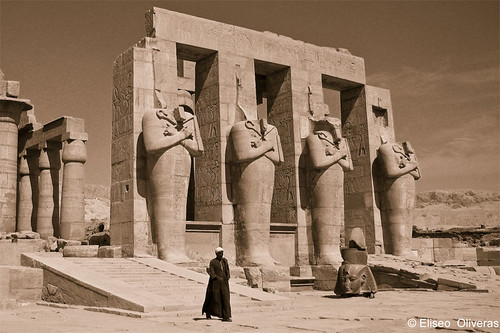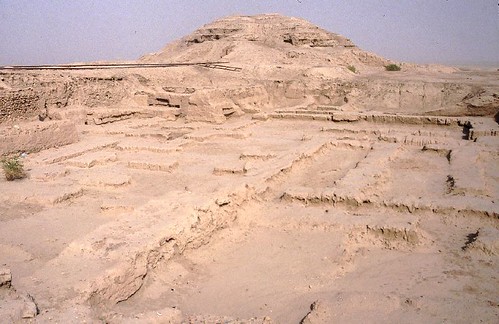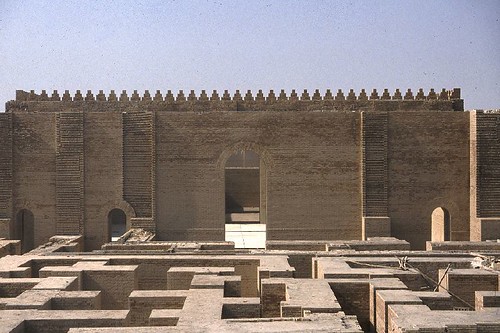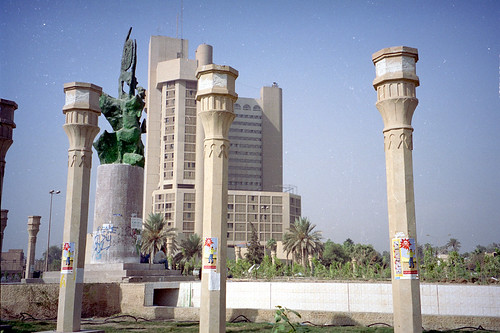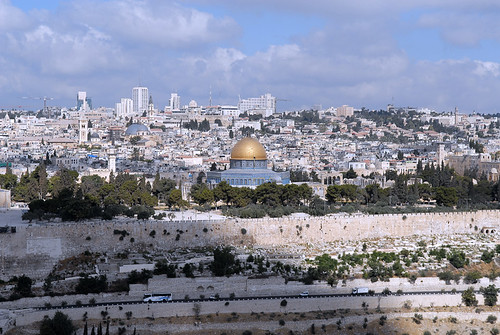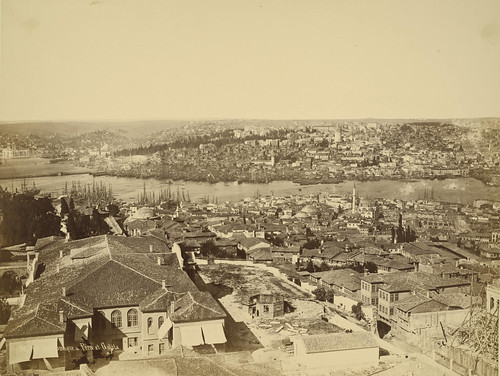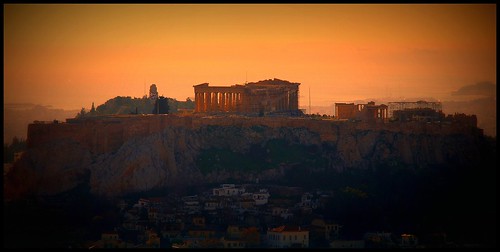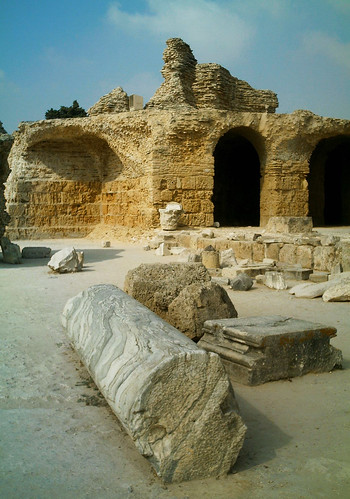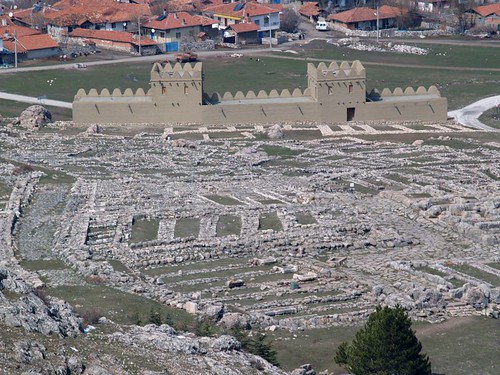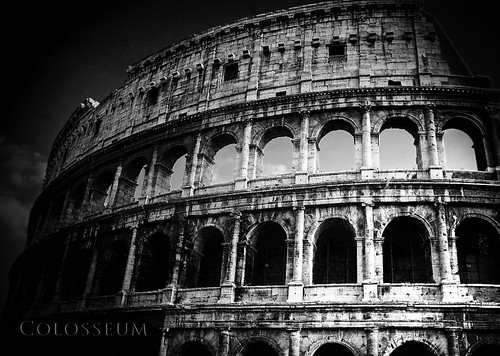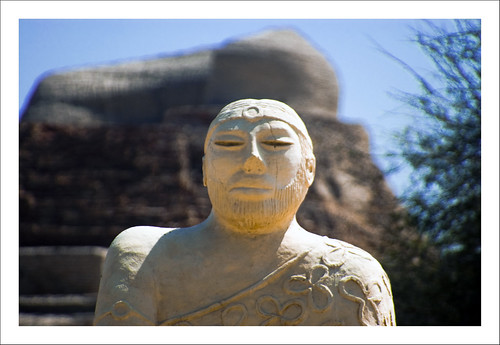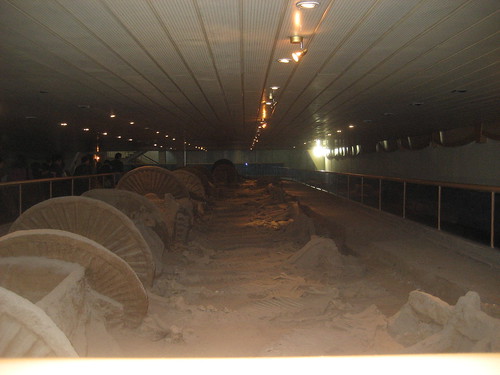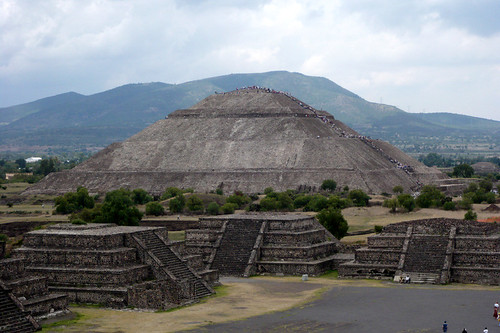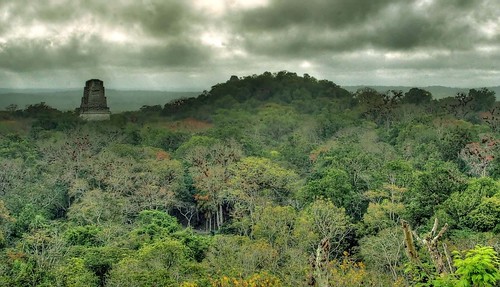Lugares de interés (POIs) del Mapa
0: Meroe, Sudan
Meroe, Sudan
Image Credit -Eliseo Oliveras.
The Sahara desert covers the length of Egypt, down to the ancient city of Meroe, close to the River Nile. This city intrigues many archaeologists for the mystery that shrouds it. Little is known about the people of this long-lost city or why they left, just vanishing without a trace. The city was flanked by some 200 Nubian pyramids around its borders, with the settlement itself located on an island within the River Nile.
Over time however, the eastern channel of the river dried up. The lack of knowledge about this royal city of Nubia also lies in the language - Egyptian was abandoned in favour of their own language, and a translation key (akin to the Rosetta Stone) has never been found. Additionally, excavations at the UNESCO-listed site are severely hampered by the unstable political climate in Sudan, where Meroe is located in the modern era.
Read more about Meroe, Sudan over at Heritage Key!
Más sobre Meroe, Sudan
1: Alexandria, Egypt
Alexandria, Egypt
Not one to have much of an ego, Alexander the Great founded the city of - wait for it - Alexandria in 331BC, and it quickly grew to become a major port city of the Mediterranean Sea. Trading with Asia and Europe led to the rapid growth of the city, and it soon became the largest city in the world, boasting the ancient world's largest library, the catacombs of Korn el Shoqafa and one of the Wonders of the World - the Lighthouse of Alexandria.
Over time, the city saw heavy influence from both Greek and then Roman occupation, as well as being home to the largest Jewish community in the world. The city was destroyed in the Greco-Jewish war in 115AD which allowed Emperor Hadrian to rebuild the city with a strong Greek architectural emphasis. Unfortunately, earthquake damage means that much of the ancient heritage has been lost, with civil and royal buildings subsiding into the harbour, and the rest being built over.
Read more about Alexandria, Egypt over at Heritage KeyMás sobre Alexandria, Egypt
2: Memphis, Egypt
Memphis, Egypt
Memphis was the capital of Ancient Egypt during the Old Kingdom and for part of the New Kingdom, and served as a key city at the foot of the Nile Delta throughout the era. For several centuries, Memphis was the biggest city in the world, reaching as many as 30,000 people during the sixth dynasty. But perhaps more interesting is the number of tombs that exist in the site where Memphis once was, known as Saqqara.
It is the Step Pyramid of Djoser and the Serapeum which are the coveted and better preserved features of the site, rather than the dwellings and temples of the city. Nevertheless, in its day it was Memphis where the government of Egypt would rule from and where the power lay for over 3000 years.
Little remains of the city today, but the sheer number of tombs demonstrates the size of this settlement. The presence of royal tombs signifies that this was a city where Pharaohs wanted to be buried, and would have established the reputation and stature of the city of Memphis.
Read more about Memphis, Egypt over at Heritage KeyMás sobre Memphis, Egypt
3: Thebes, Egypt
Thebes, Egypt
Image Credit -Eliseo Oliveras.
Thebes, although existing in the shadow of Memphis, was the capital city of Egypt for a time from 2040BC. However, Thebes is home to many important religious sites such as the famous temples of Luxor and Karnak. The city of Thebes grew its repute after a civil war led to the local government declaring themselves to be the 11th Dynasty of Pharaohs, angering the established royalty at Memphis. Egypt descended into chaos, and after a century, Theban Montjuhotep II took the war to its finale, and Thebes prevailed for the following 1500 years.
The city lives on to this very day in Luxor, with some of the most startling heritage sites - the temples of Deir el-Bahri, Karnak and Luxor, the Colossi of Memnon, and of course the famous Valley of the Kings. Though Memphis may have been the larger city with more political clout, it is the city of Thebes which has spawned some of the greatest archaeological finds in the modern era.
Many of the Lost Tombs of Thebes have been photographed by the renown Sandro Vannini as you can see in this great video which features Dr Zahi Hawass and Dr Janice Kamrin, and the images are published in "The Lost Tombs of Thebes: Life in Paradise". You can also view other Heritage Key videos shot in Thebes - Dr Farouk Gomaa's search for the diplomat Montuemhat, and Dr Hourig Sourouzian explaining the excavations and work being carried out at the Mortuary Temple of Amenhotep III.
Read more about Thebes, Egypt over at Heritage Key!
Más sobre Thebes, Egypt
4: Uruk, Iraq
Uruk, Iraq
Image Credit - World Picture Service.
The world's first city led the way in organised government, urban planning and architectural monument design as well as holding a large population of up to 50,000 people in 3000BC within its city wall. As the largest settlement of its day, the city was a powerful political force and major trading partner, located close to the Euphrates river. The city set the trend for future civilisations by operating with a well run government, organised religion and impressive public structures.
Agriculture, textile and cultural works dominated the city's industry, and trade agreements with neighbouring regions were set up to bring in construction materials and precious stones. The organisation and efficiency of the city allowed for it to be a major city for the following three millennium. Over time, the city eventually lost its prominence to other regions, and today it lies in ruins in the Iraqi desert.
Read more about Uruk, Iraq over at Heritage Key!
Más sobre Uruk, Iraq
5: Babylon, Iraq
Babylon, Iraq
Image Credit - World Picture Service.
A major city of trade and religion on the Euphrates river, and the capital of the Babylonian empire, Babylon was home to monumental architectural works such as the Tower of Babel and the famous Hanging Gardens - one of the Seven Wonders of the World. The city was greatly admired and respected as a centre for learning and culture, being home to several fine temples and palaces, protected within the city walls.
The ruins that remain date from the time of Nebuchadnezzar, who rebuilt the city, as the ancient city had been destroyed by Neo-Assyrian king Sennacherib. They were rebuilt by Saddam Hussein in 1985, who imitated Nebuchadnezzar's habit of having his name inscribed on bricks and plaques around the streets. The ruins of ancient Babylon are the largest remaining of any settlement in Mesopotamia.
Read more about Babylon, Iraq over at Heritage Key!
Más sobre Babylon, Iraq
6: Nineveh, Iraq
Nineveh, Iraq
Located opposite the modern day city of Mosul, Iraq on the bank of the Tigris river, the ancient city of Nineveh was described in the Bible to hold unlimited wealth in a desirable, exotic setting. For much of its early history, Nineveh lacked any real prominence, until Sennacherib built roads, public squares, houses and an 80 room palace, built with such grandeur that it would not be rivalled.
However, the city was sacked and razed in 612 by Medes, Babylonian and Susianian invaders who massacred the entire population and reduced the entire city to rubble. The city then took a mythical status, recounted only in tales of its former glory. Archaeologists excavating the site shed more light on the story of Nineveh, revealing it to be a trading town with rafts which carried goods along the river.
Read more about Nineveh, Iraq over at Heritage Key!
Más sobre Nineveh, Iraq
7: Baghdad, Iraq
Baghdad, Iraq
The capital of the Muslim world, as well as a centre of learning and trade, Baghdad quickly grew to be one of the largest cities in the world, if not the largest. Founded in 762AD on the western bank of the Tigris river, the city was planned to be a round circle with a diameter of approximately 2 kilometres and featuring a mosque as the focal point.
The city expanded rapidly beyond this, attaining a rich and diverse culture of people from different backgrounds and social classes. The markets of Baghdad were vibrant with international trade and inspired the many stories from Thousand and One Nights.
Read more about Baghdad, Iraq over at Heritage Key!
Más sobre Baghdad, Iraq
8: Damascus, Syria
Damascus, Syria
The oasis city of Damascus lies at the base of Mouth Kassion and is adjacent to the arid Syrian desert. Considered by its residents to be the oldest continually habited city in the world, it is the site of several religious stories from transfiguration of Abraham to the enlightenment of Saul into St Paul. The city avoided hosting a government, but instead concentrated on trade, religion and culture and developed relationships with several other ancient cities of the Levant.
In ancient times, the city has been controlled by Babylonians, Persians and Romans who have had a strong influence on the culture and lifestyle of the city. Over these periods, the city prospered and eventually grew to be the principal city of the region, taking away the prominence of rival cities.
Read more about Damascus, Syria over at Heritage Key!
Más sobre Damascus, Syria
9: Mecca, Saudi Arabia
Mecca, Saudi Arabia
The birthplace of the Prophet Muhammad, Mecca has been a key city in the region since antiquity. The city was a major commercial town from the 6th century, acting as a trade post between the Mediterranean Sea and Indian Ocean. Islamic tradition says the Koran was revealed to Muhammad while he was working as a merchant in Mecca, but he faced hostilities from the people who feared it would bring social and political change.
Muhammed fled to Medina in the north with his followers, and fought a war against the Meccans. After conquering Mecca, the shrine in the city - the Ka'ba which was constructed by the prophet Abraham - became the focal point in which direction Muslims were to pray. A pilgrimage to Mecca is one of the Pillars of Islam, which each follower must undertake during their lives.
Read more about Mecca, Saudi Arabia over at Heritage Key!
Más sobre Mecca, Saudi Arabia
10: Jerusalem, Israel
Jerusalem, Israel
With a population composed almost entirely of Jews, Jerusalem was treated as a holy place as per the readings of the Bible. A grand and stunning temple was the focal point of the city, although all that remains now is the Western Wall. It was at this temple were followers would gather, and where the original Christians would preach. As a region which had no natural resources, Jerusalem relied upon religion for prominence as a city. The international pilgrimage to the city led to investment from the ruling Roman Empire which saw heavy development in the settlement.
The topography of the city meant organised planning was difficult, so the city grew in a somewhat mosaic pattern. The strong religious beliefs held by the Jewish population was well known to the Roman overlords, and eventually the Jews grew tiresome of the disrespect shown to their religion. Devotion to the laws laid out in the Dead Sea Scrolls led to the bloody revolution of Jerusalem against the Romans in 70AD. To win back their pride, the Romans returned and flattened the city to Jerusalem to rubble in what was the First Jewish-Roman War.
Read more about Jerusalem, Israel over at Heritage Key!
Más sobre Jerusalem, Israel
11: Constantinople, Turkey
Constantinople, Turkey
Image Credit - Cornell University Library.
Originally named Byzantium after the city's founder Greek King Byzas, the name was changed after Roman Emperor Constantine I declared the city the capital of the Roman Empire in 330BC, hence becoming Constantinople. Constantine I did not trust Rome and felt it was not the ideal place to base his Christian empire anymore, feeling the focus of the new civilisation had switched to the East.
Constantinople was built in just 6 years and became the base for the Eastern Roman Empire. The Fall of Rome to the Barbarians in the 5th century meant Constantinople grew in power as the empirical wealth was poured into the city. The city of Constantinople fell to the Ottoman Empire in 1453 which signified the end of the Roman Empire.
Read more about Constantinople, Turkey over at Heritage Key!
Más sobre Constantinople, Turkey
12: Athens, Greece
Athens, Greece
Image Credit - World Picture Service.
The leading city of Ancient Greece laid down the foundations of western civilisation on the theory that an individual should be given freedom provided they acted within the laws of the state. Citizen of Athens were given the free roam to pursue their own theories and encouraged to strive for excellence. The capital of the Ancient Greek empire was also the intellectual centre of Greece, and named after Athena - the goddess of wisdom. The city was notable for being the first to establish democracy in 508BC - an Assembly was formed which would meet each month and discuss the affairs of the state.
And of course, Athens is home to some of the most stunning classical architecture - the Acropolis defines what many people associated with the city, and served as the site of a temple to Athena in the ancient era.
Read more about Athens, Greece over at Heritage Key!
Más sobre Athens, Greece
13: Carthage, Tunisia
Carthage, Tunisia
Image Credit - World Picture Service.
Carthage is a city of two lives, originally found in 814BC as a Phoenician city and centre of trade. A port city on the Mediterranean Sea, Carthage controlled the flow of trade of important materials in the western sea region. The growing prominence of Carthage saw a challenge in the growing power of Rome, and the Second Punic War saw the two powers fighting for dominance of the region. Carthage ultimately lost the War, but it was the Third Punic War which saw Rome annihilate Carthage and destroy the city in 146BC.
The Romans then built a new city on the site which became famous for artistic and intellectual contributions to society. The second Carthage was destroyed in the 7th Century AD at the hands of the Muslims. The remains of Carthage are present in the suburbs of Tunis, where few remaining traces of this ancient city remain.
Read more about Carthage, Tunisia over at Heritage Key!
Más sobre Carthage, Tunisia
14: Hattusa, Turkey
Hattusa, Turkey
Hattusa was the capital of the Hittite empire in the late Bronze Age. It was situated in rich agricultural land near the modern city of Bogazkale, and founded around the sixth millennium BC. It was king Hattusili I who made it the capital of the fledgling Hittite empire in 1586 BC. The city and the empire's peak was in the 14th century BC, when the city covered 1.8 km² with inner and outer sections, either side of a great wall (which still stands in part today) built during the reign of Suppiluliuma I. Modern estimates put the population of the city at between 40,000 and 50,000 during this period. The city and the empire's downfall occurred around 1200 BC during the Bronze Age collapse, and it was abandoned altogether until 800 BC, when a Phrygian settlement was established in its ruins. Excavations of Hattusa's ruins have been ongoing, with a few interruptions, since the late 19th century, under German leadership.
Read more about Hattusa, Turkey over at Heritage Key!
Más sobre Hattusa, Turkey
15: Rome, Italy
Rome, Italy
Rome was the heart of the Ancient Roman empire which was one of the largest in history, spanning across Europe and North Africa. Much of Roman civilisation was inherited from the Ancient Greeks, and Rome became a centre for the development of many fields such as art, architecture, law, literature, technology and religion, with its influence still felt in the Western World today. Rome began life as a small agricultural village, growing over time and changing from a monarchy to an elected republic state. The change in governance came with its controversies, and Rome was outgrowing the amount of food it could grow, leading to its reliance on food imports from its empirical colonies in Siciliy and North Africa. However, supply interruptions due to piracy, poor weather and war often meant a shortage of food and lead to riots.
When Augustus rose to power, he began the transformation of Rome through beautification of the city, and investment in public services. He also set about the creation of innovative and grand architecture and restoring religion into Roman society. The legacy of Augustus was to show that emperors were ultimately responsible for the society upon which they ruled, and the people who lived in the empire.
Read more about Rome, Italy over at Heritage Key!
Más sobre Rome, Italy
16: Cordova, Spain
Cordova, Spain
Image Credit - Agadir, Taghazout, Oued Sous-Masa National Park.
Cordova (or Córdoba) was once the thriving capital of the Caliphate of Cordova, which ruled most of the Iberian Peninsula. Located on the Guadalquivir river, the city had more cultural buildings than Rome itself. Remains including the Roman Temple built by Claudius Marcellus and the Roman Bridge are still present today. The city would flourish during the 10th century, when it enjoyed a diverse population and a stable, tolerant government. There was a prominent market and trade industry, as Cordova became famous for luxury goods such as jewellery, carved ivory and textiles. The city also was a leader in publishing, with a renown book market. Cordova today is a medium-sized city, but bears many reminders of its ancient past through architectural remains.
Read more about Cordova, Spain over at Heritage Key!
Más sobre Cordova, Spain
17: Mohenjo-daro, Pakistan
Mohenjo-Daro, Pakistan
One of the largest cities in the Indus-Valley region, as well as being one of the oldest cities in the world, Mohenjo-Daro was built around 2600BC with dwellings constructed from baked clay bricks giving it a unique style. Spread over a staggering 500,000 square kilometres, the site was initially occupied by farmers and later became a large trading city. Likely to have been a political base of the Indus Valley region, the city was laid out in a grid-pattern and had public areas such as baths and halls. The city also boasted excellent defences, despite lacking a city wall. Instead, towers and fortifications protected the city from threats. The city fell into ruins in 1900BC, although archaeologists have not been able to clarify why - theories centre around possible invasions, natural disasters or the citizens simply moving away as the river gradually shifted its path away from the city.
Read more about Mohenjo-Daro, Pakistan over at Heritage Key!
Más sobre Mohenjo-daro, Pakistan
18: Linzi, China
Linzi, China
Linzi was the capital of the State of Qi from the 9th century BC until the 3rd century BC, encompassing a period called the Warring States - named because China was in a state of total war during this period. The cities embroiled in this war needed to have heavy defences, and a strictly controlled population. The system was therefore authoritarian, with the government registering all the citizens in their city so they could be taxed and drafted into labour or military service. The development of cast iron tools made it possible for farmers to drastically increase their output of food, which allowed more growth. Trade was essential to Linzi, though the markets were strictly monitored and controlled by the state. Today, the Linzi District is a part of modern Shandong, in Eastern China, where excavations have taken place.
Read more about Linzi, China over at Heritage Key!
Más sobre Linzi, China
19: Chang'an, China
Chang'an, China
For a time in the 8th Century, Chang'an was the largest city in the world and was the capital city of China during the Tang Dynasty. With an active cultural scene and busy trade markets, the city boasted a population of over 1 million people. The site was an ideal one with a mountain range providing natural defences, and fertile lands allowing the growth of fruitful crops. The layout of the city was laid out in a grid pattern featuring two large marketplaces, and formed the urban template for numerous Asian cities to come. The city was also the host of the First Qin Emperor's imperial court, and where he built his mausoleum, protected by the famous Terracotta Warriors. The location of the city has varied slightly as various dynasties have ruled over time, and today the nearby city is known as Xi'an.
Read more about Chang'an, China over at Heritage Key!
Más sobre Chang'an, China
20: Teotihuacan, Mexico
Teotihuacan, Mexico
A powerful city which legend claims to be the birthplace of time itself, Teotihuacan had an influence which spread through the Mesoamerican region. Although a strong base of political power and cultural influence, the city interesting lacked any structural defences or fortifications. The city's trade specialised in pottery, jewellery and art with murals in particular being popular. Archaeologists have deduced much history of this city from the murals that were painted, many of which were of an ideological nature. The city also appears to have been constructed with an integrated drainage system which demonstrates the advancement in their urban planning. The city declined in the 7th or 8th century AD after the destruction of monuments along the Street of the Dead by either rioters fuelled by internal unrest, or external invaders. The site today is designated a UNESCO World Heritage site, and is one of the most visited archaeological sites in Mexico.
Read more about Teotihuacan, Mexico over at Heritage Key!
Más sobre Teotihuacan, Mexico
21: Tikal, Guatemala
Tikal, Guatemala
Tikal is home to much of the famed architecture of the ancient Maya culture. The vision of narrow pyramids protruding from atop the thick rainforests is a sight gifted by the ancient city of Tikal. The city dominated the Maya region, and its political clout, economic power and military prowess made it a formidable capital of the state. As a major trading city, the region relied upon the import of goods into Tikal which were unavailable in the natural context of the southern Mesoamerican area. Tikal is home to many palaces, monuments and temples which remain to this day, as well as the tombs of numerous dynastic rulers.
Read more about Tikal, Guatemala over at Heritage Key!
Más sobre Tikal, Guatemala




